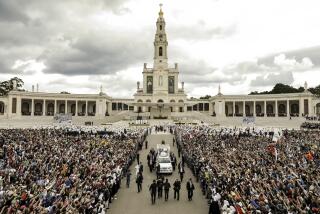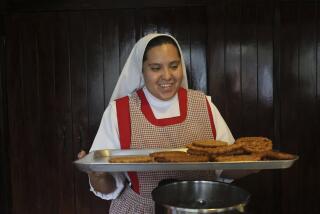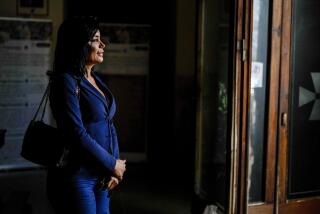Lourdes celebrates 150th anniversary of Bernadette’s visions
- Share via
Lourdes, France
When Pope Benedict XVI visits this small town in the foothills of the French Pyrenees next weekend, he will follow in the footsteps of millions of pilgrims who have come before him.
Like them, he will take Communion, drink from the holy spring and touch the stone at the base of a cliff by the Gave River, where heaven opened to a 14-year-old girl, known as Bernadette, who said she first saw the Virgin Mary there on Feb. 11, 1858. The pope will celebrate the 150th anniversary of St. Bernadette’s apparitions, with a pilgrim’s heart full of yearning for transformation.
Six million people visit Lourdes every year, including 100,000 volunteers and 80,000 ill and disabled pilgrims seeking cures for their afflictions or the strength to endure them. Since 1858, about 6,800 people have reported being cured at St. Bernadette’s grotto, though the Roman Catholic Church has proclaimed only 67 of these to be miracles and hasn’t recorded the number of spiritual healings said to have occurred at Lourdes.
Other people come just to witness the sociological phenomenon that daily unfolds; some are cynical or mystified or simply curious, in the way of travelers drawn to other holy sites around the world.
But to visit Lourdes as a tourist is a very different thing from coming here as a pilgrim, as I discovered last month when I joined a group of devout Roman Catholics from Italy for a two-day trip here organized by the Rome-based Opera Romana Pellegrinaggi.
ORP tours, aimed at taking pilgrims to holy places with spiritual guidance, are sold in North America by Toronto-based Christian World Tours, although I booked my trip from Rome. The tour was conducted in Italian by a priest and guide and included round-trip air, lodging, meals and such activities as walking the Lourdes Jubilee Way and taking part in the sanctuary’s candlelight procession.
As an American Protestant still struggling with her faith, not to mention her Italian, I knew I would face special challenges. But I speak French, which helped me in Lourdes, and, as a traveler, I look for transformation wherever I can find it.
Besides, ignorance is no hindrance at Lourdes. Bernadette Soubirous, a poor miller’s daughter, could neither read nor write when she went to gather firewood by a hill called Massabielle just outside town. Abbe François Trochu, her principal biographer, reported what happened next, in her words:
“I heard the sound of wind, as in a storm. I looked up and saw a cluster of branches underneath the topmost opening in the grotto tossing and swaying, though nothing else stirred all round. Within the opening, I saw a girl in white, no bigger than myself, who greeted me with a slight bow of the head.”
Instinctively, Bernadette knelt and prayed the rosary.
She would see the girl in white 17 more times in the next few months, standing in a recess in the cliff surrounded by branches of wild roses. The girl showed Bernadette a trickling spring close by, charged her to tell the local priest to build a chapel at the grotto and finally, on the 16th apparition, told her, “I am the Immaculate Conception.”
No one else saw the apparitions, but many people witnessed Bernadette seeing them, physically and spiritually suspended in a state of religious ecstasy like those described by St. Teresa of Ávila and St. Francis of Assisi. Water from the spring she discovered while enraptured was the source of miraculous cures reported at Lourdes, which began at the time of the apparitions and have continued to the present day.
Popular acceptance of the apparitions was astonishingly rapid, despite efforts by the town clergy and police to discourage it. As reports spread through the countryside, people began going to the grotto to see Bernadette. By March 4, the date of her 15th vision, 8,000 people crowded in to see her.
Four years after the apparitions, the local clergy deemed them divine and a church was soon built over the grotto. By 1910, bottles of Lourdes water were being sent around the world and a million people were coming to the shrine every year.
“I am here to tell you what happened. I am not here to make you believe,” Bernadette often said to doubtful people who confronted her. But the force of her testimony had the opposite effect. Belief blossomed like fields of wild roses.
PILGRIMS’ PROGRESS
Early on a Thursday morning last month, at the chapel in Rome’s Fiumicino Airport, more than 100 ORP pilgrims gathered. They were of all ages and types, but they had one thing in common: their Roman Catholic faith.
A young man behind me in line had been to Lourdes twice; a fragile older woman nearby was on her eighth trip to the shrine.
Also among the group -- and impossible to ignore -- was a corpulent, heavy-breathing, pink-faced man who complained loudly and brandished his cane in the direction of anyone who happened to be standing nearby.
Once checked in, we were given yellow ORP money pouches and scarves, which our guide told us to wear so we could recognize one another among the crowds.
The town of about 15,000 is set in a valley underneath a 14th century castle and Pic du Jer, a 3,000-foot Pyrenean peak with a lighted cross at the summit. Because of the terrain, Lourdes has an upper and a lower district, connected by winding streets and elevators.
Bernadette’s poor family home and the parish church where she was baptized in 1844 are in upper Lourdes. The grotto where she is said to have seen the Virgin Mary is below, together with hotels, shops and restaurants that pilgrims favor because of their easy access to the sanctuary.
We stayed in the lower town at La Solitude, a well-oiled package-tour hotel that was anything but solitary. The lobby was usually stacked with luggage and pilgrims waiting for buses or flights.
As soon as we arrived, we had lunch in the basement dining room. I was seated at a round table with a couple and three other solo travelers, including the rotund, complaining man who, thus far, had been given a wide berth by everyone. The Roman matron next to me, a loving middle-aged couple at my other side and the South American missionary across the table were delightful companions. But we all kept our heads down when our irascible table mate started to eat before everyone else was served and talked with his mouth full.
He didn’t understand why he hadn’t been put at the head table and commanded the waitress to bring him quiche Lorraine instead of the spaghetti puttanesca we were served. Granted, the pasta was bad. But, as Bernadette said, “You should never hear a religious talk about food. It shows a lack of an internal life.”
AT THE GROTTO
After lunch, in a drizzling rain, I walked to St. Joseph’s Gate on the south side of the park-like sanctuary that lines both sides of the Gave River and is surmounted by Massabielle hill. Once across Rosary Square, the sanctuary’s central gathering place, I followed the crowds to the grotto, tucked into an 80-foot cliff on the river side of the hill.
A line of pilgrims carrying flowers and candles waited near the altar at the base of the cliff to touch the rock, while others filled plastic jugs with water from the holy spring that pours from a row of spigots nearby.
I found a place on the esplanade by the river, so I could see over the heads of the people clustered around the grotto, a crevice about 20 feet above ground level.
In 1864, a statue of the Virgin Mary was placed there, dressed in white with a blue sash, just as the little visionary described her to Abbe Marie-Dominique Peyramale, her parish priest. When the statue was unveiled, Bernadette politely said, “It’s beautiful, but it isn’t her.”
Pictures of the grotto have been so widely disseminated that when I finally got there I felt as if I’d seen it before. Still, it moved me. Sequestered in its simple, natural setting, it is the precious heart of a sanctuary that is now home to two dozen other places of worship.
The neo-Gothic Basilica of the Immaculate Conception is the most conspicuous. Perched, Oz-like, atop Massabielle rock, it is reached by two long, curving stone ramps that embrace Rosary Square like the wide open arms of the Madonna.
The high basilica is fronted by a huge, glittering gold crown that sits on the dome of the crypt, another place of worship built into the rock. Below it is the Rosary Basilica, lined with mosaics and tablets commemorating Lourdes healings, like that of John B. Flachs, proclaiming that he was cured of deadly cancer in 1974.
Late that afternoon the ORP pilgrims assembled for Mass in the Chapel of St. Maximilian Kolbe just off Rosary Square. During the short, simple service it seemed to me that we coalesced into a congregation, a good reason for taking part in a group pilgrimage to Lourdes.
One of our number read the Gospel and the priest gave a homily in Italian that was beyond my comprehension. I felt like a duckling among swans until we got to the Lord’s Prayer, which I’d recognize in any language.
That evening, the missionary and I got to the dining room first and tried to move to another table. But the people who had sat there at lunch arrived, and we had to return to our previous places. Except for the impossible man, who remained oblivious, our table mates laughed when we sat back down, like two escaped convicts put back in prison.
Then we were served quiche Lorraine as a starter.
My eyes opened wide and I said to the curmudgeon in baby Italian, “Look, it’s quiche.”
He clasped his hands together and said, “Grazie a la Madonna.”
It wasn’t much, but it was better than vitriol. So we broke bread.
At 9 p.m. the group walked in the sanctuary’s nightly candlelight procession with a crowd of about a thousand, following a statue of the Virgin Mary carried by white-robed priests. Instead of taking part, I watched from a balcony as pilgrims holding candles and sick people in wheeled litters pushed by volunteers filed around Rosary Square.
It rained hard the next morning, but that didn’t stop the group’s celebration of Holy Communion at the Grotto. In fact, I loved the way a handful of priests, accompanied by attendants protecting them with open golf umbrellas, moved out from the altar to offer the sacrament to the crowd.
Later we walked the Jubilee Way, visiting the somber one-room apartment where Bernadette’s family lived and the parish church where she was baptized.
As the eldest, she was often in charge of her younger siblings and couldn’t regularly attend catechism class, which is why she didn’t celebrate her First Communion until 1858. After the apparitions she lived for a time in a Lourdes hospice, then left home in 1866 to become a nun at the Convent of St. Gildard in central France.
Bernadette never saw the grotto again. Hers was a brief, hard life thereafter, marked by sickness, an unsympathetic mother superior and the constant demands of people who came to the convent to meet her. Wanting to hide away at St. Gildard, she once said to a group of tourists who asked her for souvenirs, “I am not a shopkeeper.”
Long bedridden in the convent’s infirmary, Bernadette bore the cross of ill health and worried that she hadn’t done enough with the gifts God had given her. She received last rites four times before she died in 1879 and was canonized 54 years later.
You get a good view of the magnificent sanctuary that has grown up around her grotto from the medieval castle that overlooks Lourdes. It has a thoughtful historical museum and a jubilee year exhibition on other Marian shrines in Spain, England, Italy, Poland and Slovenia.
Quite apart from that, I found that pilgrims tend to be temperate. But on my group’s last night in Lourdes one of my table mates ordered Champagne, which our difficult friend quaffed right down.
After toasting, our benefactor said, “We have a beautiful table.”
More than miraculous cures and transformation, that is what Lourdes means to me: shouldering your cross, as did Bernadette, whatever it may be.
At that moment, heaven opened up a little to me.
More to Read
Sign up for The Wild
We’ll help you find the best places to hike, bike and run, as well as the perfect silent spots for meditation and yoga.
You may occasionally receive promotional content from the Los Angeles Times.






